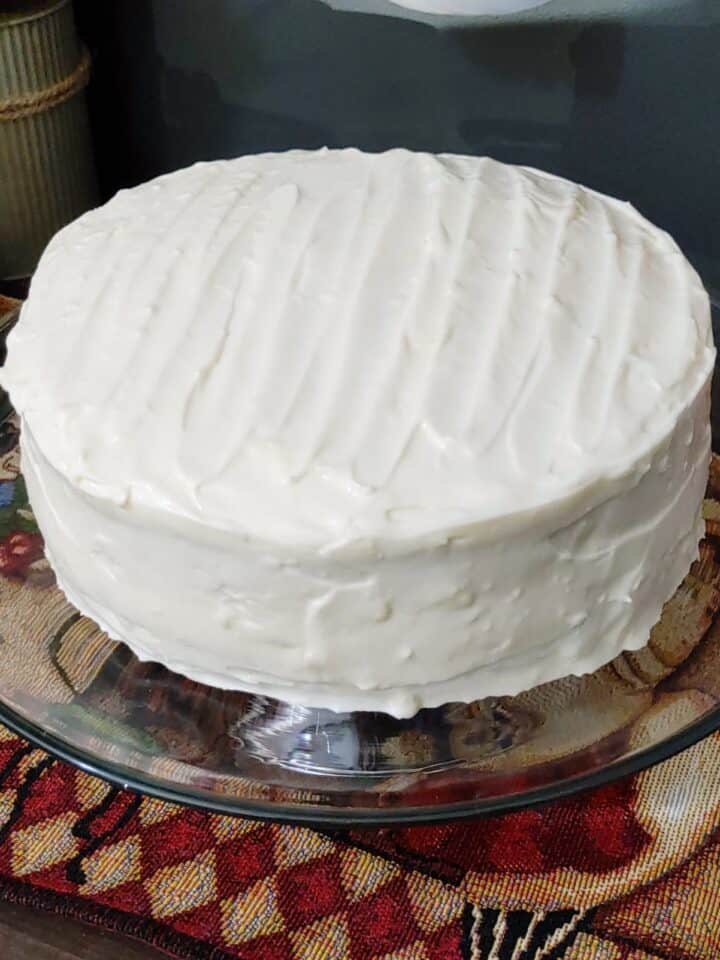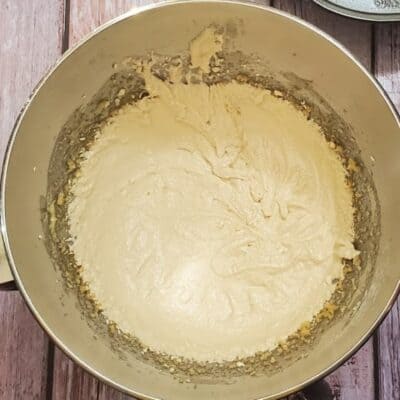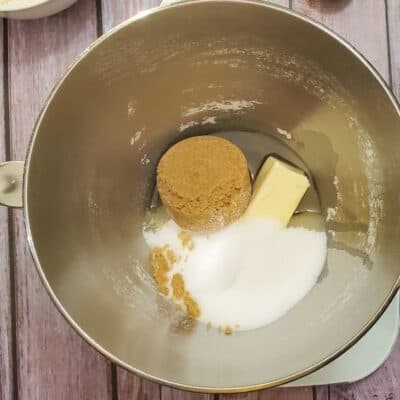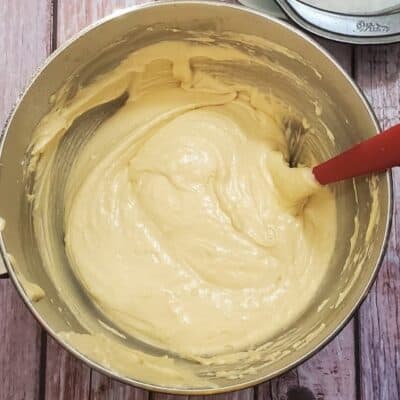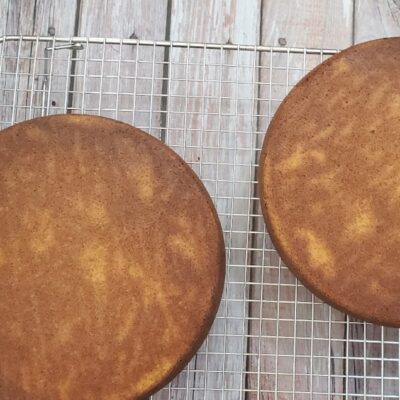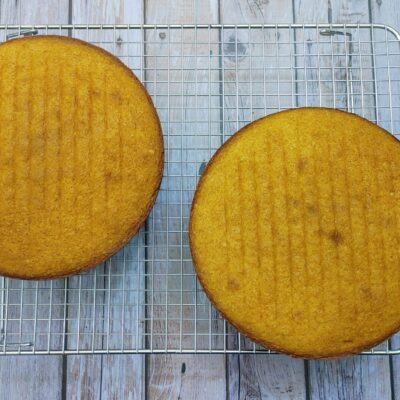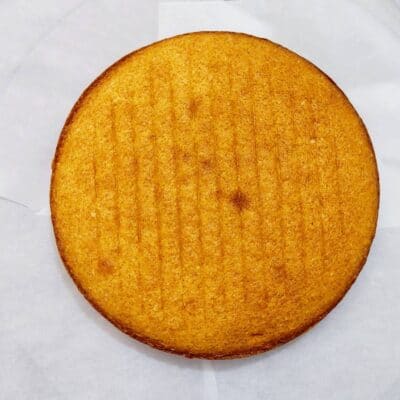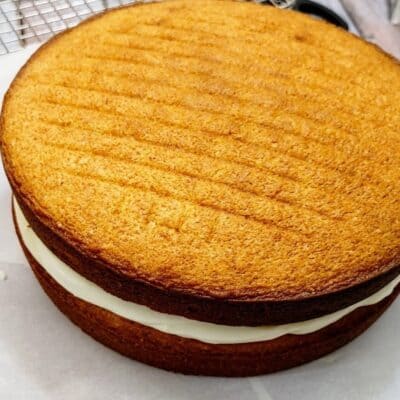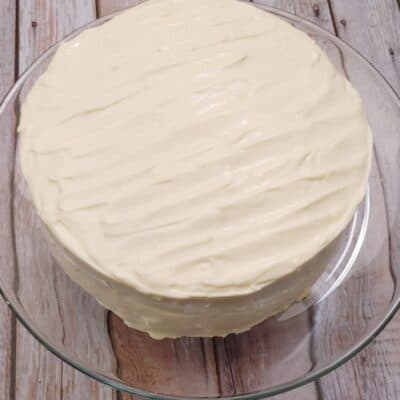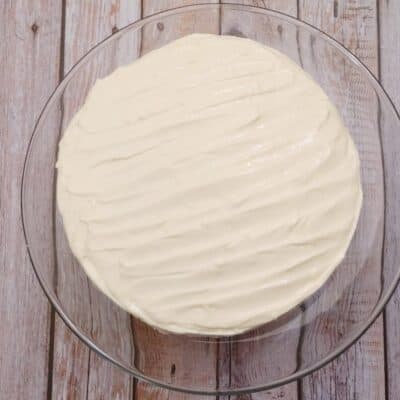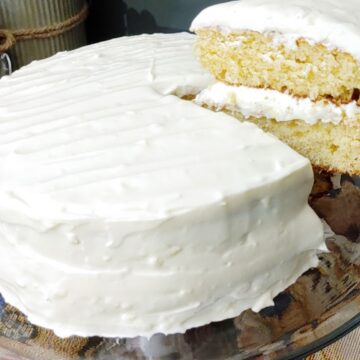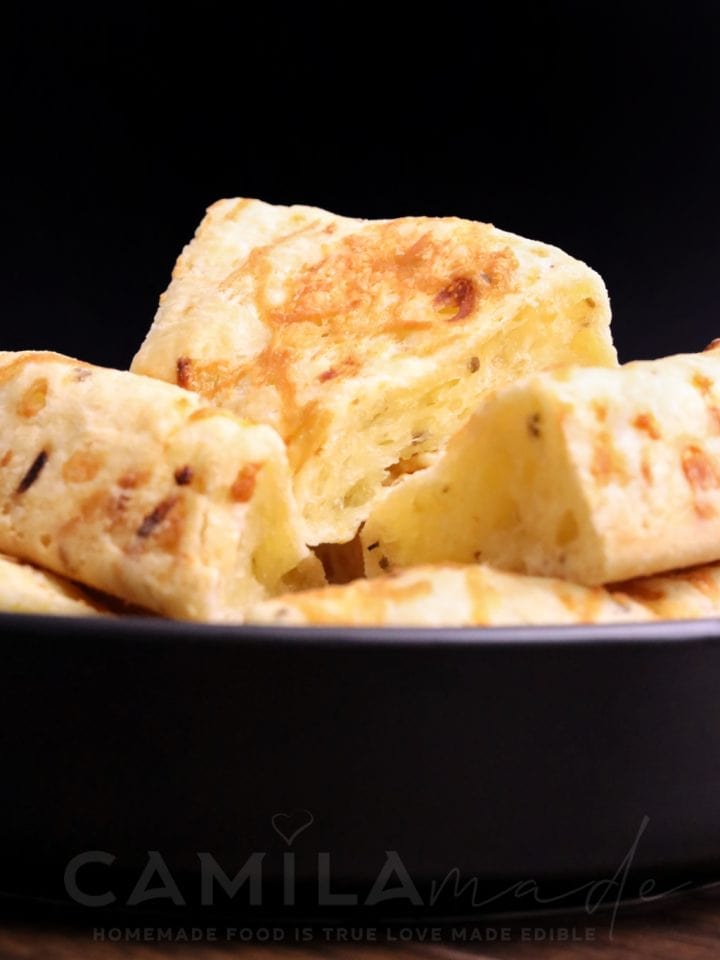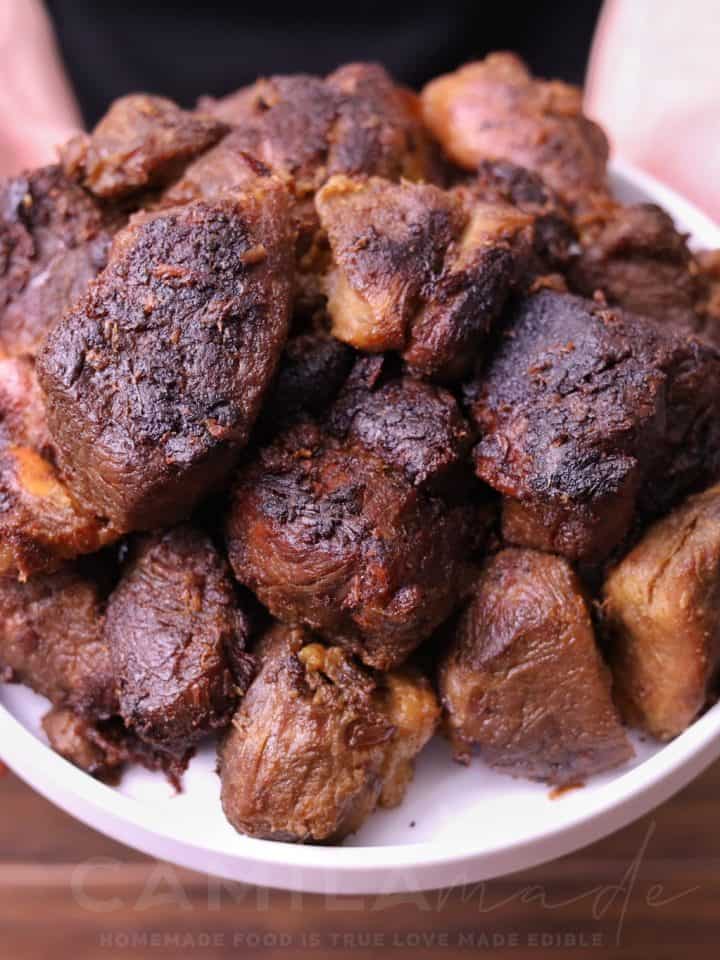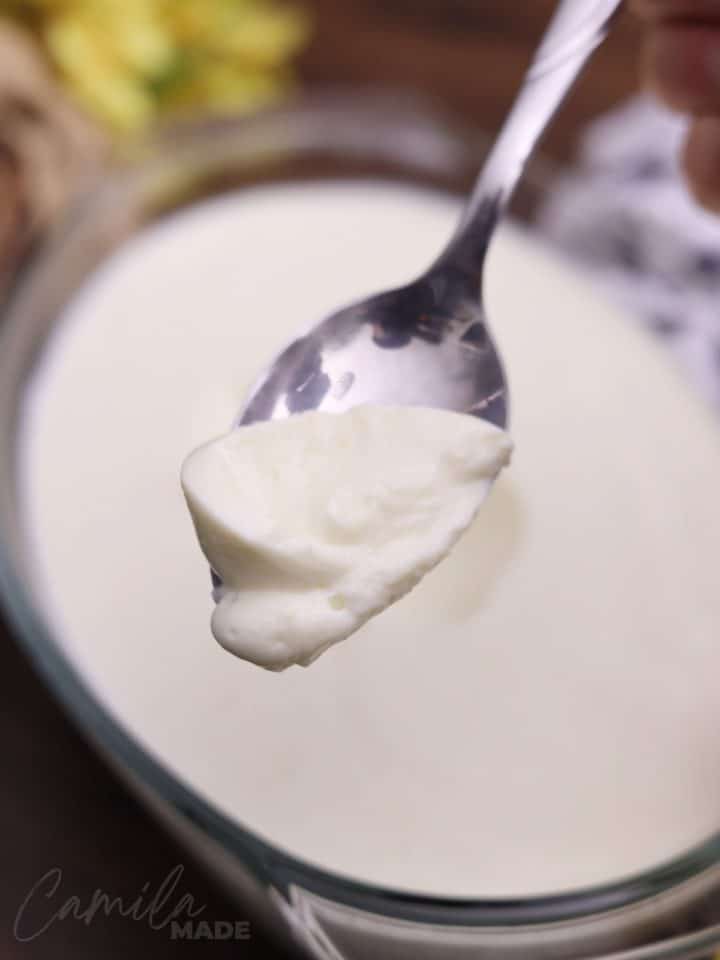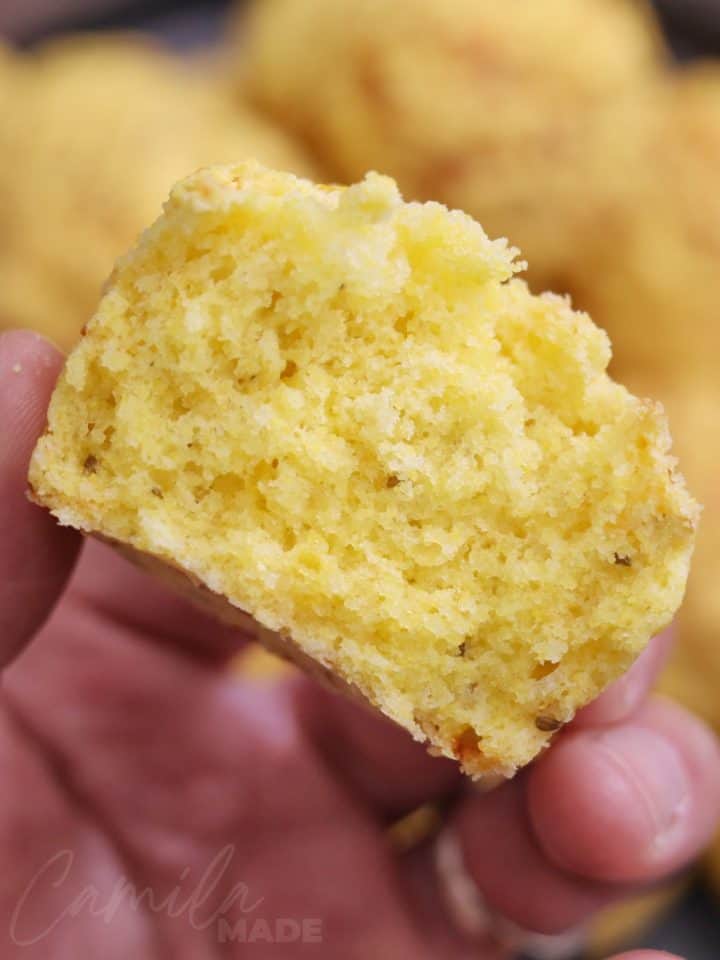This Classic Yellow Cake with Creamy Cream Cheese Frosting is sure to be a favorite! My husband and I baked this cake to celebrate the birthday of our guardian angel baby boy.
It’s a simple yet delicious recipe, featuring moist, buttery layers and a rich cream cheese frosting that makes it truly special.
Jump to:
How to Make Yellow Cake
Note: The full instructions are provided in the recipe card below.
Position a rack in the middle of the oven and preheat it to 350 °F. Spray two 9-inch cake pans with nonstick cooking spray and line them with parchment. Set aside. In a medium bowl, sift together the flour and baking powder. Set aside.
Place the avocado oil, butter, salt, and sugars in the bowl of a heavy-duty mixer fitted with the paddle attachment and beat on medium speed for about 5 minutes. Next, beat in the vanilla extract and clear vanilla.
Scrape down the sides and up the bottom of the bowl as needed. Beat in the eggs and yolk, one at a time, until combined, about 1 minute. Reduce the mixer speed to low.
Scrape the bowl and beater and add ½ of the dry ingredients mixture to the butter mixture. Add half the evaporated milk and beat until just combined.
Add the remaining dry ingredients and evaporated milk and beat quickly until combined. Do not overmix the batter! Using a rubber spatula, fold it all by hand to ensure there are no lumps at the bottom of the bowl.
Pour the batter into the prepared pan(s) and smooth the top with a metal spatula.
Bake the yellow cake(s) for about 20 to 25 minutes or until a toothpick inserted in the center emerges clean. Cool in a pan on a rack for 5 minutes, turn out onto a rack, remove the paper, and cool completely.
How to Make Vanilla Cream Cheese Frosting
In the bowl of an electric mixer, cream the butter, powdered sugar, and cream cheese until incorporated. Increase the speed to high, and mix until just combined. Don't whip!
(Occasionally turn the mixer off, and scrape down the sides of the bowl with a rubber spatula.)
Reduce the speed of the mixer to low. Add the vanilla, raise the speed to high, and mix briefly until smooth. If the frosting is too thick, add 1 tablespoon of evaporated or whole milk.
How to Assemble and Decorate
Place 4 strips of parchment paper around the edge of the cake stand or plate. Flip the bottom layer of 1 cake so the domed side faces down and touches the cake stand. Spread the top evenly with cream cheese and coconut frosting.
Then, top with the second yellow cake layer. Finally, spread the remaining frosting all over the top and sides. To decorate, use a long offset spatula to even out the frosting in a smooth layer on the side and top.
Then, use the back of a spoon to drag the frosting across the cake straight from one side to connect to the other. Repeat this process to create lovely rustic lines, wiping the frosting from the spoon after each row.
The cake is best enjoyed the day it is made, but it can be stored in a cake dome container in the refrigerator for up to 5 days.
Related Recipes:
- Perfect Carrot Cake with Cream Cheese Frosting
- Perfect Pineapple Upside-down Cake
- Perfect Red Velvet Cake with Coconut Cream Cheese Frosting
- Chocolate Sheet Cake with Mocha Frosting
- Marble Bundt Cake
📖 Recipe
Easy Yellow Cake
Tools
Ingredients
For the Yellow Cake:
- 250 g (2 cups) of all-purpose flour
- 15 g tablespoon (1 tablespoon) baking powder
- ¼ teaspoon kosher salt
- 60 ml (¼ cup / 4 tablespoons) avocado oil, grapefruit oil, or vegetable oil
- 113 g (1 stick/ 8 tablespoons) unsalted butter softened at room temperature
- 208 g (1 cup) granulated sugar
- 112 g (½ cup) light brown sugar or granulated sugar
- 3 large eggs , room temperature
- 1 large egg yolk , room temperature
- ¾ cup buttermilk, full-fat evaporated milk or whole milk at room temperature
- ½ tablespoon pure vanilla extract
- ½ tablespoon clear vanilla
For the Vanilla Cream Cheese Frosting:
- (1) 8 oz full-fat cream cheese, softened
- 250 g (2 cups) sifted confectioners' sugar
- 113 g (1 stick) unsalted butter softened but still cool to the touch
- 2 teaspoons pure vanilla extract
- 1 teaspoon clear vanilla
Instructions
- For the Yellow Cake: Position a rack in the middle of the oven and preheat it to 350 °F. Spray two 9-inch cake pans with nonstick cooking spray and line with parchment. Set aside. In a medium bowl, sift together the flour and baking powder. Set aside.
- Place the avocado oil, butter, salt, and sugars in the bowl of a heavy-duty mixer fitted with the paddle attachment and beat on medium speed for about 5 minutes. Next, beat in the vanilla extract.
- Scrape down the sides and up the bottom of the bowl as needed. Beat in the eggs and yolk, one at a time, until combined, about 1 minute. Reduce the mixer speed to low. Scrape bowl and beater and add ½ of the dry ingredients mixture to the butter mixture, and add half the evaporated milk and beat until just combined.
- Add the remaining dry ingredients and evaporated milk and beat on low speed until combined. Do not overmix the batter! Using a rubber spatula, fold it all by hand to ensure no lumps at the bottom of the bowl. Pour batter into prepared pan(s) and smooth top with a metal spatula.
- Bake the yellow cake(s) for about 20 to 25 minutes or until a toothpick inserted in the center emerges clean. Cool in pan on a rack for 5 minutes, turn out onto a rack, remove the paper, and cool completely.
How to Make Vanilla Cream Cheese Frosting
- In the bowl of an electric mixer, cream the butter, powdered sugar, and cream cheese until incorporated. Increase the speed to high, and mix until just combined. Don't whip! (Occasionally turn the mixer off, and scrape down the sides of the bowl with a rubber spatula.)
- Reduce the speed of the mixer to low. add the vanilla, raise the speed to high, and mix briefly until smooth. If the frosting is too thick, add 1 tablespoon of evaporated milk or whole milk.
How to Assemble and Decorate
- Place 4 strips of parchment paper around the edge of the cake stand or plate. Flip the bottom layer of 1 cake so that the domed side faces down and touches the cake stand.
- Evenly spread the top with the cream cheese coconut frosting. Then, top with the second yellow cake layer. Finally, spread the remaining frosting all over the top and sides. To decorate, use a long offset spatula to even out the frosting in a smooth layer on the side and top.
- Then, use the back of a spoon to drag the frosting across the cake straight line from one side to connect to the other. Repeat this process to create lovely rustic lines, wiping the frosting from the spoon after each row. The cake is best enjoyed the day it is made, but it can be stored in a cake dome container in the refrigerator for up to 5 days.
Notes
Yellow cake can be stored in the freezer for up to three months. To thaw the cake, remove it from the freezer and let it sit at room temperature for a few hours or overnight in the refrigerator. Once thawed, the cake can be frosted and served as desired. It is important to note that the cake's texture may change slightly after freezing and thawing, but the flavor should remain the same.
All nutritional information is based on third-party calculations and is only an estimate. Each recipe and nutritional value will vary depending on the brands you use, measuring methods, and portion sizes per household.
